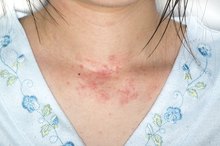What does fact checked mean?
At Healthfully, we strive to deliver objective content that is accurate and up-to-date. Our team periodically reviews articles in order to ensure content quality. The sources cited below consist of evidence from peer-reviewed journals, prominent medical organizations, academic associations, and government data.
The information contained on this site is for informational purposes only, and should not be used as a substitute for the advice of a professional health care provider. Please check with the appropriate physician regarding health questions and concerns. Although we strive to deliver accurate and up-to-date information, no guarantee to that effect is made.
Complications of a Skin Abscess
Skin abscesses are pus-filled pockets that develop just under the skin as a result of infection due to bacteria, injury, or infected hair follicles or nearby tissue. Many abscesses will drain and heal on their own or after home-care treatment, such as the application of warm compresses; however, special treatment from a physician may be required. Complications arising from skin abscesses can become serious, so it is important to seek prompt medical care should signs of serious infection arise.
Common Complications
As the skin abscess develops, it may appear as an open or closed lesion or a dome-shaped nodule (raised bump) 2. The tissue on and around the skin abscess may harden 2. The pus-filled wound may also spontaneously drain or ooze fluid.
Rare Complications
How to Get Rid of Folliculitis Scars
Learn More
In some cases, abscesses are the result of infection with multiple types of bacteria, according to St.Vincent Health. While this infection may remain localized to the skin, in rare cases it may spread throughout the body, signifying a more extensive infection. When this occurs, people will often develop a fever or chills. If you notice either of these symptoms, contact your doctor right away.
- In some cases, abscesses are the result of infection with multiple types of bacteria, according to St.
- When this occurs, people will often develop a fever or chills.
Serious Complications
The infection that began at the site of the skin abscess may spread to nearby tissue and throughout the body, leading to serious complications 2. Many new abscesses may form on the joints or other locations on the skin. Skin tissue may die as a result of the infection, leading to gangrene and possible skin loss or amputation. As the infection makes its way through the body internally, it can lead to a condition called endocarditis--an inflammation of the inside lining of the heart. Endocarditis can be fatal if not treated early, and many people will require long-term antibiotic therapy and hospitalization to treat the condition.
- The infection that began at the site of the skin abscess may spread to nearby tissue and throughout the body, leading to serious complications 2.
Recurrence
Amputation Due to Cellulitis
Learn More
Some people may experience a recurrence of skin abscesses after they have healed. St. Vincent Health advises that people with recurring skin abscesses should be evaluated by a doctor to rule out infection with methicillin-resistant Staphylococcus aureus (MRSA)--a type of bacteria that is resistant to commonly used antibiotics 1. MRSA infections start off as small red bumps that quickly become skin abscesses. The abscesses may then penetrate the body, causing life-threatening infection that spreads through the bloodstream and affects internal organs. The Mayo Clinic recommends seeking medical care if you notice pus, skin redness or fever, and that you ask to have the lesion tested before starting antibiotic therapy.
- Some people may experience a recurrence of skin abscesses after they have healed.
- The abscesses may then penetrate the body, causing life-threatening infection that spreads through the bloodstream and affects internal organs.
Related Articles
References
- Mayo Clinic: MRSA Infection
- NIH: Skin Abscess
- Kolar SL, Liu GY. Targeting bacterial abscess formation. EBioMedicine. 2016;12:16-17. doi:10.1016/j.ebiom.2016.10.017
- InformedHealth.org [Internet]. Cologne, Germany: Institute for Quality and Efficiency in Health Care (IQWiG); 2006-. Boils and carbuncles: Overview. 2018 Jun 14.
- Creech CB, Al-zubeidi DN, Fritz SA. Prevention of recurrent staphylococcal skin infections. Infect Dis Clin North Am. 2015;29(3):429-64. doi:10.1016/j.idc.2015.05.007
- Patterson, JW. Practical Skin Pathology: A Diagnostic Approach. Amsterdam: Elsevier Health Sciences; 2013.
- Toomey A, Le JK. Abscess, breast. [Updated 2019 Jan 11]. In: StatPearls [Internet]. Treasure Island (FL): StatPearls Publishing; 2019 Jan-.
- National Health Service. Treatment abscess. Update November 4, 2019.
- Baiu I, Melendez E. Skin abscess. JAMA. 2018;319(13):1405. doi:10.1001/jama.2018.1355
- Murren Boezem, J. KidsHealth from Nemours. Abscess. Update September 2017.
- Wolf, K; Johnson, R.; and Suurman, R.. "Section 22. Bacterial infections involving the skin." Fitzpatrick's Color Atlas & Synopsis of Clinical Dermatology (5th ed.). 2005; McGraw-Hill Professional; ISBN-13 978-0071440196.
Writer Bio
Based in New York City, Tricia Mangan began her writing career in 2001. She has co-authored a National Cancer Institute report and a number of research articles that have appeared in medical journals. Tricia holds a Master of Arts in clinical psychology from Stony Brook University and boasts diverse clinical, research and teaching experience.







